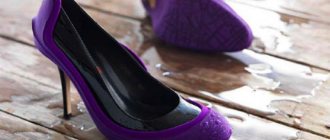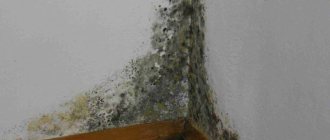Mold is a consequence of impaired air exchange and high humidity. The appearance of spores in the closet can be caused by improper placement of furniture. For example, it is not recommended to place a wardrobe near the bathroom or in a corner.
Other reasons for the appearance of fungus may be:
- clothes not washed with antiperspirants,
- poorly dried things,
- special chemical composition of fabrics,
- poor quality furniture material.
You can get rid of mold forever only after eliminating the factors, otherwise it is useless to remove the fungus; after a while, the spores will appear again.
Causes of bad odor
Before you start fighting mold, it would be a good idea to first understand the reasons for the bad smell in your clothes closet:
- The appearance of fungus can be caused by poor-quality materials from which the cabinet is made: dangerous spores may initially live in the wood;
- Storing wet linen or poorly washed fabrics that emit a stale odor in a closet;
- An increased level of humidity in a room leads to the appearance of mold in furniture, especially if it is made of natural wood;
- Mold can also appear if the furniture is positioned incorrectly: in an angular position, the risk of dampness in the wardrobe increases;
- Sometimes mold can be caused by clothes already contaminated with spores in the closet;
- Close location of the cabinet to the kitchen or bathroom;
- Rare ventilation and washing of the wardrobe followed by drying can also cause mold.
In addition to the reasons described, tissues with a special chemical composition can also be a source of infection.
Causes of fungus in residential buildings
The normal humidity level for a comfortable life is within 70-80%. If there is a high level of humidity in your home, moisture begins to accumulate in a variety of places. It is in these places that the fungus appears, rapidly spreading over the entire surface of the walls, ceiling, furniture and clothing.
Dampness and humidity are the main causes of mold in the home. The following has an unfavorable effect on the indoor microclimate (increased humidity):
- Uneven heating of rooms, poor ventilation.
- Buildings without waterproofing, high thermal conductivity of corners.
- Heat loss in end rooms, increased area of external walls.
- The heating is turned off ahead of time and there is no rush to turn it on in the fall.
- Metal-plastic windows without microventilation mode.
- Low-power ventilation, especially in the kitchen and bathroom.
- Improper use of bathrooms.
- A large number of indoor plants, animals, an aquarium.
Why does mold grow on clothes?
- dampness in the room where the cabinet is located;
- arrangement of furniture in the corner of the room;
- storing wet clothes;
- spread through the washing machine if the fungus appears in it;
- lack of normal air circulation in furniture;
- the furniture is tightly closed and has no cracks, rarely opens;
- unwashed items are folded;
- old furniture with rotten areas.
Furniture processing
Carry out the treatment only after the closet is completely empty of clothes. Today, there are several simple methods that can at the same time kill harmful spores and save wood from further damage. Let’s look at the 2 most effective ones.
The most common method is to treat wood with soda solution. This method is suitable even for a cabinet with children's underwear, as it is safe. Dissolve 3 tbsp in a liter of water. l. soda, then wash the inside of the cabinet with the resulting solution, including all sides, shelves, walls and doors. Leave the cabinet open for 4 days. You can also use hydrogen peroxide. Treating children's cabinets with peroxide is as safe as using soda.
See also: What will help destroy mold on wood?
Another effective method is chlorine bleach. But keep in mind that this method of dealing with the problem is not suitable for everyone, since chlorine causes an allergic reaction in many people. The method is suitable for processing a closet where the clothes of adult family members are stored. Carrying out such treatment is unacceptable for disinfecting children's furniture.
First, you should remove all clothes from the closet and dry the inner surface using a special dryer or fan, and only then proceed directly to disinfection. It is better to take the wardrobe out of the room into the open air so as not to breathe in harmful fumes.
Mix equal parts water and chlorine bleach, put on gloves and use the resulting solution to wipe all the walls and shelves of the cabinet, inside and out. When done, wash the cabinet with clean water. It is advisable for the wardrobe to stand for about 3 days in the fresh air, which will help eliminate the unpleasant smell of chlorine.
When processing wardrobes using this method, you do not need to add additional detergents to the water so as not to harm your health. Using bleach allows you to completely clean the surface, which ordinary soda, which is best used at the initial stage of infection, cannot cope with.
Preparation
Before you can get rid of the smell in your closet, you need to remove it from your clothes. Mold can grow in the cells of the fabric, so clothing should be carefully inspected.
Furniture should also be inspected for visible signs of mold. If we are talking about old furniture, then you can easily find an ancient mothball that has been ruining your life all this time.
Try moving furniture away from the wall. In some cases, this eliminates the problem since the source of the mold is located there.
After emptying the wardrobe and all cabinets, remove the shelves. After this you can start working.
How to get rid of mold in a closet?
Not everyone is comfortable emptying a closet completely for a long time in order to wash it.
This is especially true for people who have nowhere else to put their things.
Then other useful recommendations on how to get rid of dampness in a closet with clothes will come to the rescue.
- Immediately sort through the fabrics and inspect them for mold. Wash contaminated items immediately, iron everything else with a warm iron or, if possible, ventilate in the fresh air;
- To get rid of mold, it is often enough to simply move the wardrobe to another location. The sunny side of the room is perfect for this - sunlight on the cabinet walls will lead to the death of spores and quickly eliminate excess moisture;
- Temporarily keep the cabinet open to allow maximum fresh air into it - this will help eliminate dampness;
- Organize your outfits so that items you don't wear are stored in separate, sealed bags. The remaining things need to be laid out more freely so that they do not crowd together. Pay special attention to products made from genuine leather and fur.
- To get rid of fungus in the closet, modern store-bought sprays are suitable. But they will only be effective if you wash the contaminated cabinet walls in advance and ventilate the wardrobe, since they often only provide a flavoring effect.
See also: How to deal with mold in an apartment?
It is impossible to get rid of harmful spores in a clothes closet without taking things out. Therefore, try not to let the situation get worse and inspect the wardrobe in a timely manner.
What to do to prevent mold from appearing on clothes
Special moisture absorbers will help keep clothes in the closet.
Undoubtedly, when people see traces of mold on their clothes, they think about how to get rid of them. However, it is much easier to prevent them from occurring than to search for removal methods and clean out the entire cabinet.
The following measures can be noted to prevent the occurrence of fungus on things:
- To prevent fungi from growing on clothes, you should not put them in a closet while wet;
- any washed item should be sent to dry immediately so that humidity does not contribute to the formation of mold on it and other things;
- if mold has formed in a wardrobe, you need to wash it as soon as possible and thoroughly ventilate all things;
- in order to prevent trouble from occurring, you need to monitor the level of moisture in the rooms; this requires regular ventilation and heating of the room with special devices;
- It would be a good idea to place special moisture absorbers on the shelves of your wardrobe.
In order not to think about how to remove mold stains, you should treat things with special attention, wash and air them in a timely manner. Don’t forget about the microclimate of the room, the level of moisture in which determines the likelihood of fungus occurring.
How to remove mold from clothes?
It's much worse when mold appears on the fabric. The chance of returning the fabric to its original normal appearance and removing the unpleasant odor depends on its type, the intensity of the damage and the methods used to combat mold.
- Table vinegar helps get rid of mold in the form of stains and odors on fabric. It should be added in a small amount to the drum of the washing machine and spin the clothes there for a couple of cycles. For best results, it is recommended to pre-soak light-colored fabric in vinegar water (about 5 tablespoons of vinegar per liter of water), then wash and rinse thoroughly. This method helps get rid of both stains and unpleasant odors;
- You can remove stains and unpleasant odors from pure white fabrics without a pattern using bleach or bleach. But if we are talking about synthetics, it is not recommended to use this product, since the fabric may acquire a yellowish tint;
- It is quite possible to get rid of mold and odor on silk and wool with the help of turpentine. To do this, simply soak a cloth in it and wipe the affected areas, then wash and dry thoroughly;
- Linen and cotton linen are best disinfected in hot water with the addition of laundry soap and soda, as other substances can damage the fabric;
- If we are talking about colored fabrics, then you should work especially carefully: the design may fade, and then there will be no point in removing mold stains. Try the product in advance on a small area of the fabric from the inside - if the pattern does not deteriorate, you can safely use the product. Ammonia, which should be diluted in equal proportions with hot water, has worked well in this case. The resulting solution is used to wipe the affected areas;
- A product based on water and oxygen bleach will remove stains and odors from white synthetic laundry. Pour bleach into boiled hot water and soak the fabric in it for an hour, stirring lightly. After this time, rinse the clothes.
There are also cases when mold has become so deeply embedded in the fabric that nothing can be done to remove it. Then all that remains is to say goodbye to such a thing without hesitation.
The appearance of fungal spores in the closet with clothes is easier to prevent than to deal with the problem later. Therefore, ventilate the furniture more often, sort out the things in it and make sure that the wood is not damp!
See also: How to save wallpaper from mold?
Fighting unpleasant odor
An invisible but very annoying enemy is the specific smell of damp clothes.
To get rid of this odor, the following remedies will be useful:
- Vinegar 9% – dilute laundry detergent with vinegar to a creamy consistency, then wash the clothes.
- Soda - add two to three tablespoons of it to the washing powder when washing.
- Vodka – mix vodka and water in small quantities, spray on fabric, dry well in the sun.
- Borax - dissolve a tablespoon of the substance in water, add a little washing powder, and leave the clothes in this solution for a couple of hours. Then wash it.
More detailed information is provided in this article.











